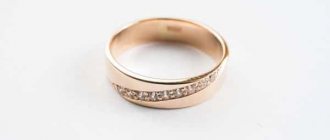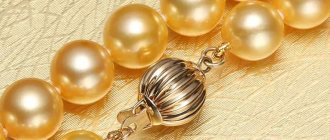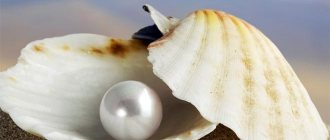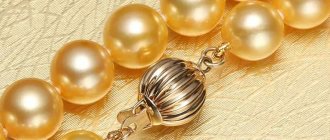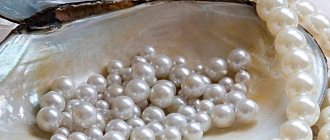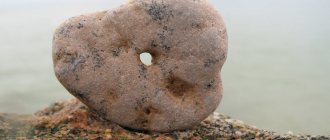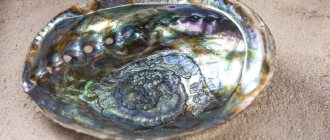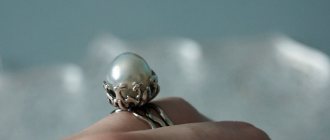History and origin
Pearl is a stone of organic origin. It is not a mineral, from the point of view of scientists, but according to a tradition that is about four thousand years old, it is classified as a precious stone. The cost of pearls was very high until the 20s of the 20th century, and subsequently decreased significantly due to the collapse of the market as a result of the work of Japanese pearl farms.
Pearl
Pearls are formed in the organisms of various marine and freshwater mollusks and are a product of a natural rejection reaction to a foreign object that has entered the shell of a mollusk - a grain of sand, a shell fragment, etc. If this object comes into contact with the mollusk's mantle (the outer soft shell hiding under the shell), the mollusk covers it with a layer of the same material that makes up its shell. As a result, a pearl is formed.
In the same shell of an invertebrate animal, up to several dozen pearls of different shapes can form, but the more there are, the smaller they are, accordingly. Only those pearls that have a mother-of-pearl shell are valued.
Zoologists believe that any species of mollusk is capable of producing pearls, but they find pearls only inside some bivalves and gastropods, as well as in the shells of a single species of cephalopod - the famous nautilus.
Scientists believe that the first pearls were caught by fishermen by accident - discovered while catching edible bivalves. This happened about four thousand years ago, in the waters of the shallow Gulf of Mannar (a pseudo-sea between Hindustan and the island of Ceylon). Due to the fact that pearls are the only precious stone that does not require additional processing, they began to be used as jewelry, as well as as a monetary equivalent.
Pearl
Pearls were very highly valued throughout the East - from Eastern China, the extreme point of mainland Asia, to North Africa - Egypt, Numidia and ancient Carthage. The importance of pearls for the ancients was so great that the famous Queen Cleopatra considered earrings with two large pearls to be the most valuable of her jewelry. Statues of gods and heroes were decorated with pearls, pearls were awarded for military exploits, and pearls were given for love. It was highly valued in all countries that had access to the sea, although prices varied depending on the color, size and shape of the pearl.
The origin of the Russian word “pearl” is associated with the Chinese name for this stone - “zhen zhu”, which came to our country through the ancient Turkic and Volga-Bulgar languages. In most European languages, the name has the Latin root perl. It comes from a no longer used word that denoted a specific type of shellfish that was harvested by the ancient Latins. In Russian, nacre is a synonym for pearls; in a more precise meaning, it is the “front” coating of a pearl.
WHAT COLORS ARE PEARLS IN NATURE?
The color spectrum of pearls includes 120 different shades. When evaluating a pearl, the colors are taken into account along with the shape and size.
The best natural pearls have no color and look snow-white. Thanks to its translucency, it has a soft silvery sheen and barely noticeable shimmers with the colors of the rainbow in the light.
Earrings made of natural white pearls 8 mm, 500 USD
The value of multi-colored pearls is determined depending on the purity and rarity of the color.
The most expensive pearls are blue, lilac, pink, gold and black of good saturation.
Natural pink and orange pearls from 3.3 mm to 13 mm
What determines the color of pearls
The appearance of white and colored pearls is determined by the following factors:
- type of mollusk;
- degree of transparency of the mother-of-pearl layer - the more transparent it is, the lighter the pearl;
- color of the organic layer under the mother of pearl;
- concentration of pearl aragonite and conchiolin in the shell - aragonite is colorless or white, and conchiolin has shades from to black;
- saturation and composition of impurities of chemical elements in water.
Jewelry classification system
The jewelry industry uses the following gradation of pearls:
| Quality | Shine | Defects | Selection of beads in the product | Configuration | Mother of pearl thickness |
| AAA | great | 95-99% absent | excellent | spherical | thick |
| AA+ | great | 90-95% are absent | excellent | spherical | thick |
| AA | very good | 80-90% are absent | very good | spherical | medium to thick |
| A | good | minor | good | close to spherical | average |
| B, C | Pearls with surface defects or low luster are practically not used in the jewelry industry. The exception is valuable types of baroque and semi-baroque. | ||||
Physicochemical characteristics
From a chemical point of view, it is a composite of an inorganic substance - calcium carbonate, and an organic substance - conchiolin, a horny substance produced by the mollusk. When examined under a microscope, a layered structure is revealed, with layers of different natures not touching each other.
The chemical formula of the substance is very complex, since conchiolin is a natural polymer of a protein structure. The hardness of pearls is low, 3–4 units on the Mohs scale. It is easy to drill, but cannot be sanded, since in this case the mother-of-pearl layer is erased. It is opaque, but individual pearls may be translucent (depending on the type of pearl).
| Property | Description |
| Formula | CaCO3 |
| Color | White, yellowish, silver, golden, cream, blue, green, black, gray, pink |
| Shine | Pearl |
| Transparency | From translucent to opaque. |
| Hardness | 3-4 |
| Cleavage | Absent |
| Kink | Shellish |
| Density | 2.6-2.78 g/cm³ |
Price
The cost of pearls depends on the following parameters:
- size;
- colors;
- shine;
- surface cleanliness (no defects);
- origin;
- forms.
The most valuable are spherical pearls with a thick mother-of-pearl layer, a smooth surface, and a bright shine.
Pear-shaped and oval-shaped specimens are less valued by jewelers.
There are connoisseurs of “baroque” (irregularly shaped) and “paragon” pearls (reminiscent of figures of people, animals, and plants).
The cost of sea pearls is usually 5–6 times higher than river pearls , since the latter are on average smaller and less often have a regular spherical shape.
Cultured pearls are usually cheaper than natural pearls, although they are not artificial. But some of its specimens are valued higher than those generated by nature.
Color plays an important role in the evaluation of this stone. The highest cost is for “wild” specimens of the following colors:
- black;
- deep blue;
- white without the slightest tint.
Moreover, these pearls should be large (from 10 mm in diameter) and perfectly round in shape.
Yellow copies have the lowest price.
10 mm in diameter , can be bought for $380–400 , and equivalent in quality, 15 mm in size, for $1,500 , since such large specimens are rare.
Examples of prices for pearl products that can be purchased in Russian online stores:
- bracelet made of pink pearls - 711 rub. ;
- small river pearl beads, white (45 cm) - 712 RUR. ;
- bracelet made of cultured pearls - 1180 rub. ;
- beads made of white cultured pearls (43 cm) - RUB 2,470.
Mining locations
Pearls are obtained by opening the shells of marine and freshwater mollusks, mainly bivalves (the closest example is the mussel). The main areas for harvesting sea “wild” pearls are warm, shallow seas:
- Gulf of Mannar;
- Persian Gulf;
- Red sea.
Cultured pearls are mined off the coast of Japan, as well as in some lakes in the Land of the Rising Sun. Cultivated pearls are no different from wild ones, except that on pearl farms the core of the future pearl is artificially placed in mollusk shells. After this, the invertebrate grows (and grows the jewel inside) under the supervision of specialists for several years.
Cultured mother-of-pearl is not artificial or counterfeit, but its price is significantly lower due to controlled production. However, it depends on the color of the pearl, its size, shine and other parameters. Some cultural specimens are valued as precious stones more than those generated by nature.
Cultured pearls
There are also freshwater pearls, which are mined in large and clean rivers in Asia, Europe and North America. Its cost is lower, since (on average) it is smaller than sea and less often has a regular spherical shape. The main suppliers of freshwater pearls are Russia, Germany and China.
VARIETIES OF PEARL BY TYPE
Natural pearls are divided into types:
- by place of formation - marine/freshwater;
- according to the living conditions of the mollusk - natural (wild)/cultivated.
Natural natural
Until the 19th century, pearl fishing consisted only of catching shellfish in the wild. The process itself was complex and life-threatening - the catchers dived to great depths, holding their breath for a long time.
Also, with the traditional method of mining, it was necessary to check a large number of shells before finding even one pearl. This led to the massive destruction of shellfish and environmental deterioration (shellfish are natural water filters in nature).
Harvesting pearl mussels in the wild has been officially prohibited worldwide since 1952.
Today natural pearls are obtained from:
- purchasing antiques;
- accidentally finding pearls in edible shellfish;
- through poaching.
There are pearls of sea and river (freshwater) origin.
Sea pearls
Sea pearls are more expensive due to their characteristics and more complex extraction technology. Mollusks that live in the seas are demanding on weather conditions, temperature and water composition and produce 1-2 pearls from one shell.
Peculiarities:
- grows faster than river;
- large (average size 8-14 mm);
- spherical or rare baroque forms are often found;
- rich palette of colors;
- strong shine due to a thick layer of mother-of-pearl
Freshwater
River pearl mussels are less fastidious and produce up to 20 pearls. Therefore, river (freshwater) pearls are easier to obtain, and their price is an order of magnitude lower than sea pearls.
Peculiarities:
- harder than the sea
- small (average size 3-11 mm);
- the layer of mother-of-pearl is thinner;
- soft matte shine;
- the palette is narrower than that of the sea, but there are original striped and spotted colors;
- It is distinguished by a variety of configurations - only 2% of pearls are round in shape.
We recommend: Outlandish BLUE AMBER
Cultured natural
Cultured pearls are also natural, so they should not be confused with artificial pearls.
Brooch with cultured pearls and rubies (1995), designed by Salvador Dali
Attempts at cultivation were made in ancient China. At that time, the production of pearl figurines of saints flourished. The items were briefly placed in the shellfish and then emerged covered in a thin, iridescent layer. Of course, the quality of mother-of-pearl was low.
The progress of pearl cultivation was mainly hampered by the low level of biological sciences - people simply did not understand why pearls appear in mollusk shells.
Only in 1893, the Japanese Kokichi Mikimoto created the first pearl farm, making a breakthrough in the field:
- cultivation has made it possible to program the shape, color and size of pearls - most manufacturers are constantly working to improve the breed of mollusks, rejecting those unable to create high-quality pearls;
- It became possible to engage in pearl fishing without harming the environment.
Externally, natural and cultured pearls are indistinguishable. The main difference between them is the way the foreign object enters the sink.
Cultured pearls are similarly divided into sea and river (freshwater) pearls, preserving the basic characteristics of each type.
Cultured pearls in Bali
Cultured pearls still have minor differences:
- otherwise they let light through;
- density is higher than natural;
- fluoresce more intensely in X-rays;
- When an electric current is passed through, they begin to rotate, while natural pearls remain at rest.
However, these features are discernible only with specialized equipment and do not affect the appearance of the pearls.
Artificial
Despite the massive cultivation of shellfish, high-quality pearls are still an expensive pleasure. Therefore, as technology develops, people come up with new cheap analogues.
Main methods of imitation:
| Materials | Peculiarities | Differences from pearls |
| Glass | Glass is the very first material for imitation pearls:
|
|
| Plastic | The most popular method of imitation due to the variety of technologies and low cost of production. |
|
| Surface painting | Allows you to achieve maximum similarity to the original:
|
|
| Artificial improvement of the properties of natural pearls | Some manufacturers and suppliers artificially improve the appearance of low-quality pearls by:
|
|
Colors and varieties
Pearl colors range from milky white to various light shades of green, blue and pink. Available in silver, grey, deep green and black. Color plays an important role in the evaluation of pearls: black, deep blue and completely white (without the slightest shade of cream or gray) specimens are most valued, since they are the rarest in nature.
Mother-of-pearl gives a specific play of light on the surface - from soft yellow to blue and pink. This occurs because light interferes with the irregular, wavy surface of the pearl, which only appears smooth.
Jewelers classify pearls by size, color, luster, thickness of the nacre layer, surface cleanliness (absence of defects) and shape. The most valuable specimens are those in the form of a perfect sphere with a thick layer of mother-of-pearl, without visible defects and with a bright shine. Pear-shaped and oval pearls, as well as irregularly shaped specimens, are less valued. But some connoisseurs have so-called “monsters” or “paragons”, which outwardly resemble figures of people or animals.
The shape and color of the pearl depend on the type of mollusk, the salinity and purity of the water in which it lived, as well as its temperature.
Types of pearls:
- river - natural, small (up to 7 mm in diameter), white, cream, yellowish or grayish in color, shape varies from spherical to elliptical;
Freshwater pearl necklace - "Tahiti" - cultivated, medium size (up to 12 mm in diameter), shades from silver to black;
Pearls "Tahiti" - “Akoya” - cultivated, all colors except blue, diameter up to 14 mm;
"Akoya" - “king” - natural, large (up to 22 mm), of all colors, with a thick layer of mother-of-pearl, found only in the southern seas;
"King" - "Mabe" - natural, very large, perfectly round in shape, color range - from silver through lead gray to black;
"Mabe" - "Kasumi" - cultured Japanese pearls of exotic colors, from gold to purple;
"Kasumi" - “Baroque” (as well as “paragons” and “monsters”) - small, up to 5 mm, different shades of white, gray and cream, irregular in shape.
Baroque pearls
Products made from artificially grown or synthesized mother-of-pearl stones stand apart. Imitation pearls are always perfectly spherical in shape.
CLASSIFICATION OF PEARLS BY SHAPE
The shape of the pearl depends on the following factors:
- location in the shell;
- core shape;
- age of the pearl;
- mollusk pathologies;
- type of mollusk
- cultivation method.
We recommend: DELICIOUS FINGER: Stone of Power
Guide of the US-Japan Pearling Association
The pearl industry uses the following classification of pearls by shape:
- The sphere is a perfectly round pearl. The shape is checked by the traditional method - if you roll the pearl on a flat surface, it should not deviate from a straight line.
- Hemisphere - has a slight deviation from the spherical shape. A pearl may look perfectly round, but when rolled on a flat surface it deviates from a straight line. Valued almost on par with spherical.
- Rice is another subspecies of spherical pearls, but with a distinct oval shape. A mandatory quality condition: symmetry.
- Drop - a bead sharply tapers towards one end. The cost of a geometrically correct teardrop-shaped pearl can exceed the price of a spherical analogue. Well-chosen paired sets of earrings and pendants are especially appreciated.
- Beads are a small type of pearl up to 2.5 mm in size.
- Blister - formed on the inside of a mollusk shell. During the mining process, it is cut out along with part of the shell. It has less strength compared to other types and is used as cabochons.
- The button is round and flat like pearl buttons.
- Baroque is the name given to irregularly shaped pearls. Often valued for its unusual configurations and colors.
- Semi-Baroque - pearls retain a spherical, symmetrical shape, but have surface defects - grooves or bulges.
Medicinal properties
The healing properties of pearls are associated, firstly, with its ability to diagnose the body, and secondly, with the ability to restore problem areas in organs associated with the removal of excess fluid from the body and the digestive tract. Pearls are suitable for those who suffer from stomach diseases associated with changes in acidity, and also have problems with the kidneys and liver, and to a lesser extent, with the intestines.
The diagnostic properties of pearls are due to the fact that they change their color if the acidity of the upper layers of the skin changes in the owner. This in itself indicates unfavorable processes that have begun in the body. Some lithotherapists believe that if a pearl fades, loses its shine and becomes cloudy, this means the emergence of a tumor process in the body (mainly in the abdominal organs). Thus, mother of pearl signals when it is time to see a doctor to check the whole body. To some extent, it is able to “slow down” the development of the disease.
People suffering from conjunctivitis and other eye diseases associated with constant discharge from the eyes can wear pearls. It will help reduce the amount of discharge.
Magic properties
The magical properties of pearls are similar to healing ones. The main one is the ability to darken, fade, lose color if the owner is negatively affected (damage, the evil eye, other types of magical attacks). But at the same time, pearls are a very finicky stone. He wants to protect and protect only people who are pure in soul, and even among them he does not like those who are wayward, prone to fits of anger or pride.
Kasumi pearls with smoky surface
Pearls cannot stand people who are unable to keep their word, who are treacherous and deceitful. Including those who lie to themselves.
In different cultures, pearls are symbols of purity, purity, sincerity of thoughts and the predominance of the divine (sublime) over the earthly (carnal). In Asian countries, jewelry with pearls is used as amulets and at the same time detectors of bad thoughts and intentions directed at the owner. The scope of application is wide: business transactions, love affairs, health and childbirth, maintaining peace and order in the family and so on.
Contraindications
Please note: the properties of pearls are such that this stone is not suitable for anyone. It should not be worn by weak-willed people who are prone to weakening self-concentration and depression, especially men who have problems with self-esteem and an unstable psyche. The magic of pearls is suitable mainly for women, for them it enhances classic feminine qualities - softness, maternal wisdom, gives femininity and charm. If pearl products are worn by men, then the characteristic features of a woman’s character are transmitted to them.
This is beneficial, for example, for business people, businessmen and politicians who could use a little flexibility and flexibility in negotiations. Pearls love such people, it brings them good luck and protects them from dangers. But for men with an initially labile, mobile psyche, especially creative ones, pearl talismans will lead to a personality disorder - even to a psychiatric diagnosis.
You should not wear pearls that previously belonged to another person if you are not sure of the personal qualities of the previous owner. It captures and stores for a long time the emotional and energetic impression of the previous owner. This means that your grandmother's pearl necklace may pass on some of her problems to you.
Baroque pearls or baroque pearls
Baroque pearls
Gold bracelet with baroque pearls from Ray Griffiths
This is the general name for pearls that have an irregular original shape, regardless of their place of origin. Due to its unusualness and exclusivity, it is highly valued among many jewelry designers. Instead of the classic perfect ball, baroque pearls can resemble a drop, a disk, a cylinder, or a pear.
Especially notable are the so-called paragons - pearls that have the outlines of animals, human faces, bird wings, wolf fangs, etc. They have always been endowed with mystical properties and worn as talismans and amulets. In addition to their unusual shape, Baroque pearls are often distinguished by a ribbed pattern on the surface, similar to what sea waves leave on the sand.
Each pearl is unique and inimitable, so the demand and price for them remain at a consistently high level.
Zodiac compatibility
The magical properties of this stone are most widely manifested under the influence of the planetary forces of the Moon and Water (or more precisely, the Ocean). Pearl is not just a water stone, but a sea stone; astrology believes that of all the stones it is closest to the power that plays with the ebb and flow of the tides, moving huge masses of water across the surface of the planet. This stone has absorbed the strength, grandeur, suspiciousness and changeability of the Ocean, so it can be worn by most water signs.
Pearl
Pearls are most compatible by zodiac sign with Pisces and Cancer. The exception is Scorpio, the most complex, dangerous and unpredictable sign. Scorpio is “dark” water, the cold, dark depths of the Ocean, where mysterious and terrible creatures live. Therefore, Scorpios can only wear black pearls.
According to the horoscope, the stone is not suitable for such zodiac signs as Taurus, Virgo or Capricorn. Deep Water doesn't like Earth because he can't conquer it. Mother-of-pearl jewelry will try to suppress the will of representatives of earth signs - but there will be much fewer problems with fire signs.
| Zodiac sign | Compatibility (“+++” – fits perfectly, “+” – can be worn, “-” – strictly contraindicated) |
| Aries | + |
| Taurus | +++ |
| Twins | + |
| Cancer | +++ |
| a lion | — |
| Virgo | +++ |
| Scales | + |
| Scorpion | + |
| Sagittarius | + |
| Capricorn | + |
| Aquarius | + |
| Fish | + |
(“+++” – fits perfectly, “+” – can be worn, “-” – is strictly contraindicated)
Compatibility with other stones
Pearls are incompatible with sapphire, which reflects the surface of water. He does not like proximity to the stones of the Earth, especially jasper, cacholong, morion and chalcedony.
The optimal proximity is with other water (except sapphire) stones:
- emerald;
- opal;
- moonstone;
- aquamarine;
- alexandrite.
Jewelry with pearls.
Partnership with Air is acceptable:
- amethyst;
- uvarovitis;
- topaz;
- hyacinth;
- chrysoprase;
- smoky quartz.
Avoid proximity to Fire minerals, especially ruby, diamond and all types of garnets, including greenish grossular.
Application area
Pearls are a popular inclusion in expensive jewelry. It is used to create designer rings, necklaces, tiaras, beads, pendants and any other works of jewelry. The most valued are blue and black “wild” pearls, ideally round in shape and large in size, from 10 mm in diameter.
The traditional metal of the frame is white and yellow gold, less often platinum. Silver is rarely used in combination with pearls, and mainly with pearls of gray and silver shades.
Abalone pearls
Abalone pearls. Photo: pearlparadise.com
Pendant with abalone pearls. Photo: jchapahernandez.com
Abalone is one of the very rare varieties of pearls. It is born in a single-vave mollusk of the same name, which is also called abalone or abalone. Due to the anatomical features of the mollusk, Abalone pearls are extremely difficult to cultivate.
Advertising - Continued below
Abalone mining is mainly carried out in the USA on the California coast and in Mexico. However, this type of pearl is often found in other countries, such as Japan, Australia, Korea, New Zealand, South Africa and Thailand.
The abalone mollusk is truly ancient, the age of the species is about 30 million years. But its main feature is the incredible palette of shades with which the inner surface of the shell shimmers - the pearl born in it can boast of the same play of colors. Blue, green, lilac, beige, orange, pink abalone pearls are very highly valued in the jewelry market - and the brighter the color, the more expensive.
It is worth noting one more feature of this variety - the vast majority of pearls found are shaped like a horn or shark tooth, and they are not perfectly round at all. For the same reason, the closer a gemstone is to the correct shape, the more valuable it is. Good abalone pearls with a diameter of 3-4 millimeters can cost from $300 and above.
How to wear and care
There are a number of rules for wearing pearl jewelry. Firstly, etiquette requires a small number of pearls for young girls; if it is a necklace, then no more than one strand of pearls in it. Heavy headwear with mother-of-pearl is appropriate for older ladies to wear.
Secondly, products with colored pearls are worn only alone. A large number of green, pink or blue pearls is a sign of bad taste.
Rings with pearls are worn on the ring finger.
Ring with pearls
This stone needs to be carefully looked after. Protect it from direct sunlight, and after prolonged contact with skin, rinse with water without using a sponge. When cleaning products, only the gentlest “chemistry” is allowed, for example, tooth powder.

